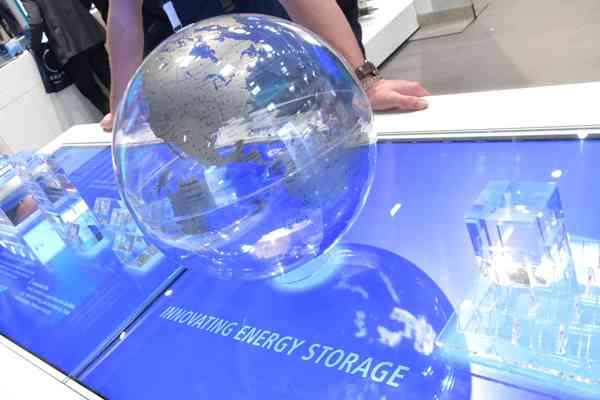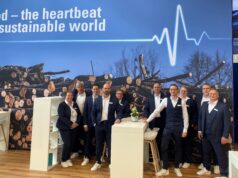
After remaining at a stable yet high level in 2018, the global expansion in renewable energy capacity started to pick up speed again this year. According to the International Energy Agency (IEA), the deployment of new capacity will have increased by just under 12 percent in 2019 compared to the previous year, which is the strongest level of growth since 2015. The agency predicts that a total of almost 200 gigawatts of capacity will be added worldwide, driven predominantly by photovoltaics and wind power. The IEA forecasts that on its own the global photovoltaics market will even expand by more than 17 percent this year compared to 2018. ees Europe, the continent’s largest and most international exhibition for batteries and energy storage systems, is also benefitting from these developments and will be even bigger than before in 2020. Although the exhibition is still six months away, more than 90% of the exhibition area has already been booked. ees Europe will take place at Messe München from June 17 to 19, 2020 as part of The Smarter E Europe, the innovation hub for new energy solutions.
As in 2018, new solar installations will once again surpass the 100-gigawatt mark globally in 2019 and are even expected to exceed the amount reached in the previous year. Onshore wind capacity is also experiencing rapid growth and newly installed capacity is anticipated to climb by 15 percent worldwide to 53 gigawatts, propelled predominantly by the USA and China. There are also encouraging signs surrounding the deployment of new offshore wind capacity, which is likely to remain stable at around five gigawatts of growth in 2019. The IEA considers these technologies to be the key pillars of global efforts to fight climate change, reduce air pollution and provide everyone with access to energy.
Electrical energy storage systems hold the key to meeting climate protection targets
According to Bloomberg New Energy Finance (BNEF), continuously falling costs will result in renewable energy, supported by lithium-ion battery storage systems, accounting for 48 percent of all energy generated worldwide by 2050 (currently 7 percent). Photovoltaics and wind power are already the least expensive sources of electricity in two-thirds of countries around the world. As explained by BNEF analysts in their latest New Energy Outlook forecast, Europe will be the leading proponent of decarbonization worldwide. They expect carbon prices and other supporting measures to lead to the continent generating 92 percent of its electricity from renewable sources by 2050. The forecast also predicts that oil will no longer be used as a source of energy by the middle of the century and coal – which currently generates 37 percent of all electricity – will only be used to meet 12 percent of our electricity requirements.
Large grid storage projects and innovative solutions
The energy transition would fail without energy storage, which is why the number of new largevolume storage projects is on the rise. In the Netherlands, energy group Vattenfall has spent a good 60 million euros on building and combining a 22 megawatt wind farm, a 38 megawatt photovoltaic installation and a 12 megawatt battery storage system all in one location. The utility company’s first full-hybrid power plant is also expected to serve as a blueprint for what Germany could achieve
without the aid of subsidies from 2020. In particular, Vattenfall has Germany’s coal fields in its sights, as it believes that old mining land offers huge potential for photovoltaics and wind power.
The utility company Allgäuer Überlandwerke (AÜW) has constructed a hybrid power plant with a new battery storage system connected to a gas turbine. According to AÜW, it is the first such plant in Germany that has been approved for the primary control reserve market. The energy storage system was put into operation in August 2018 on the premises of AÜW in Sulzberg, Germany, with an output of 16 MW and a capacity of 8.5 MWh. The company currently uses the battery storage system to stabilize the power grid.
Since the Tesla big battery in Australia was commissioned, its performance and business model has been a source of fascination within the industry. Tesla founder and CEO Elon Musk recently confirmed that the 95 million dollar installation would pay for itself within a few years. Owned and operated by Neoen Australia, the battery storage system receives annual payments of four million dollars from the government for the provision of grid services.
Storage community supplies balancing power using virtual grid energy storage system
Privately owned solar storage units are involved in a pilot project for congestion management being conducted by grid operators TransnetBW and Netze BW. The new digital platform DA/RE is using these storage facilities as a virtual battery to help develop new congestion management strategies. An intelligent control system charges or discharges the decentralized solar storage systems in the region as needed, for instance to divert energy away from overloaded grid nodes. The closer a storage device is to a congested area, the more effectively it can intervene to help ease the load for the entire power grid. The pilot project, which was launched in April 2019, is being supported by the Baden-Württemberg Ministry of the Environment. In addition to various grid and plant operators, the company sonnen is participating in the project with a virtual power plant consisting entirely of decentralized domestic storage systems.
New business models and innovative companies at ees Europe
These innovative examples demonstrate how there is incredible dynamism within the storage market and that an increasing number of new solutions are being developed to store the growing quantities of electrical energy being generated and to make it available in line with demand. From CATL, BYD, Samsung SDI and LG Chem to Tesla, SAFT, Varta, sonnen, E3DC, Solarwatt and SENEC, the market leaders in the storage industry will once again gather at ees Europe at Messe München from June 17 to 19, 2020 to present their solutions and business ideas to an expert audience.
Image source: © Solar Promotion GmbH Picture caption: Three days at ees Europe in Munich – the start for innovative storage projects worldwide
ees Europe and the parallel exhibitions Intersolar Europe, Power2Drive Europe and EMPower will all take place from June 17 to 19, 2020 as part of the innovation hub The smarter E Europe at Messe München.
For more information, please visit:
www.ees-europe.com/en
www.TheSmarterE.de/en












































